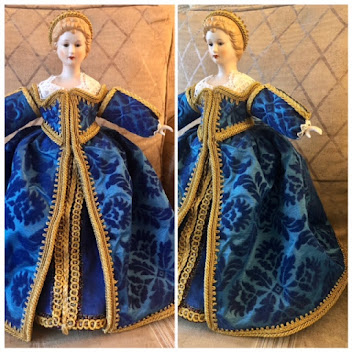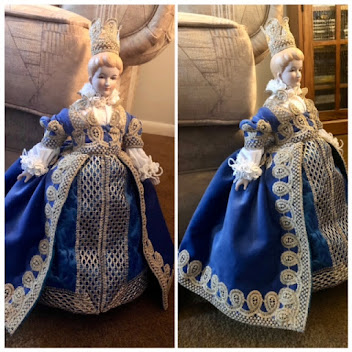Born 1509 the border of what is now Claire and Limerick counties, Ireland. Mairin O'Cadhla is an Irish shepardess aged 21 years. Coming from a large family of Irish Shepards, she knows how to dye, wash, spin, and knit wool to make clothing and thread. Mairin was taken from all she knew, during the invasion of Ireland by the English in 1530.
Separated
from her family and thought dead from the war, Mairin was captured and kept to
be sold as a servant woman. Mairin was relocated in a large ship along with
many strangers with odd accents and language going back to England. She was acquired and placed
in the noble household De Vere’s of Warwickshire, who were prominent in the
Tudor court.
Over time as
she worked in the household, Mairin showed her skills with wool in all its
forms. Growing the favor of the lady of the house, Mairin was rewarded for her
patience, diligence and knowledge, which was profitable for the household. Lady
De Vere was pleased, and handpicked
Mairin to be taught the skills to be a lady's maid. She eventually lost some of her
Irish accent as she became accustomed to her new noble home.
In exchange
for her confidences, Mairin accompanied Lady De Vere to court on several
occasions for many years. While attending her lady at court, Mairin learned
many fine pursuits. She was expected to be mannerly, gain knowledge, and be
devout just like many a fine woman. Mairin learned: prayer and devotion to the
word of God, courtly dances, embroidery, sewing, playing the lute, care of fine
clothing, care of fine jeweled accessories, keeping the company of children at
court and keeping cheerful company to her lady and household.
She eventually wed to fine gentleman similar to her station, to a wonderful household master of horse Lord Justin du Plott. The couple had 6 children 3 of which made it to adulthood. Her husband passed in 1558 due to a bad bout with the pocks. Mairin passed in 1560 of illness due to old age, though it is said more to be of a lonliness for her husband. Their issue Mistress Marie Patrica du Plott, Master Thomas Larue du Plott and Master Michael Joshua du Plott.
Her eldest daughter Marie Patricia grew up in the De Vere household and also followed in the footsteps of her mother plying her knowledges to gain postion. Spending time under her mothers tutilidge as a young girl. Eventually she went to court with the household with a comission to work as a lady in waiting in the English court. Gaining more at court Marie eventually wed to a minor noble son, a 4th son of an Duke.
Her son Thomas Larue took on the family trade with becoming a Master of Horse. To which he became known throughout as an excellent breeder of hunting horses. A hearty breed of English horse mixed with some distant lines of the stockier breeds of Irish native horses. He married similar to his station with the lute teacher from the De Vere household.
Her youngest son, Michael Joshua also stayed with the De Vere household, but chose to become a master gardner. He had apprenticed with another household of Lord Cecil and was renoun for creating complex designed knot gardens and certain varieties of fruit trees. After the apprenticeship he came back to work for the De Veres providing gardens to set off the grandness of the De Vere Manor. He also married similar to his station to a well known court lace maker and embroideress.
Her eldest daughter Marie Patricia grew up in the De Vere household and also followed in the footsteps of her mother plying her knowledges to gain postion. Spending time under her mothers tutilidge as a young girl. Eventually she went to court with the household with a comission to work as a lady in waiting in the English court. Gaining more at court Marie eventually wed to a minor noble son, a 4th son of an Duke.
Her son Thomas Larue took on the family trade with becoming a Master of Horse. To which he became known throughout as an excellent breeder of hunting horses. A hearty breed of English horse mixed with some distant lines of the stockier breeds of Irish native horses. He married similar to his station with the lute teacher from the De Vere household.
Her youngest son, Michael Joshua also stayed with the De Vere household, but chose to become a master gardner. He had apprenticed with another household of Lord Cecil and was renoun for creating complex designed knot gardens and certain varieties of fruit trees. After the apprenticeship he came back to work for the De Veres providing gardens to set off the grandness of the De Vere Manor. He also married similar to his station to a well known court lace maker and embroideress.






No comments:
Post a Comment